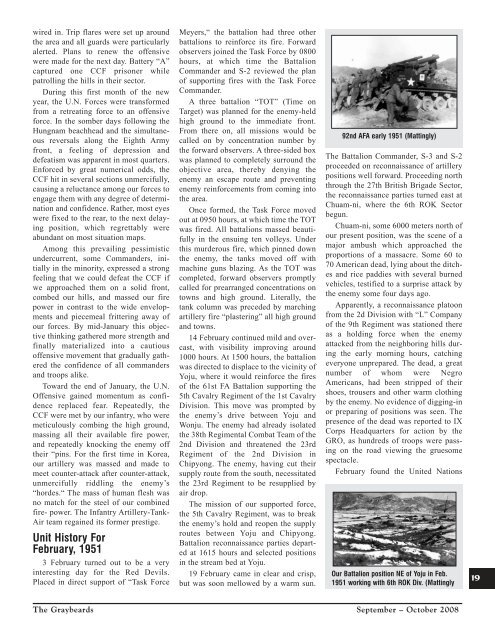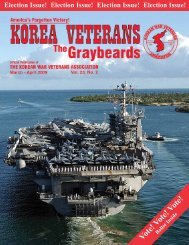Sep/Oct 2008 - Korean War Veterans Association
Sep/Oct 2008 - Korean War Veterans Association
Sep/Oct 2008 - Korean War Veterans Association
Create successful ePaper yourself
Turn your PDF publications into a flip-book with our unique Google optimized e-Paper software.
wired in. Trip flares were set up around<br />
the area and all guards were particularly<br />
alerted. Plans to renew the offensive<br />
were made for the next day. Battery “A”<br />
captured one CCF prisoner while<br />
patrolling the hills in their sector.<br />
During this first month of the new<br />
year, the U.N. Forces were transformed<br />
from a retreating force to an offensive<br />
force. In the somber days following the<br />
Hungnam beachhead and the simultaneous<br />
reversals along the Eighth Army<br />
front, a feeling of depression and<br />
defeatism was apparent in most quarters.<br />
Enforced by great numerical odds, the<br />
CCF hit in several sections unmercifully,<br />
causing a reluctance among our forces to<br />
engage them with any degree of determination<br />
and confidence. Rather, most eyes<br />
were fixed to the rear, to the next delaying<br />
position, which regrettably were<br />
abundant on most situation maps.<br />
Among this prevailing pessimistic<br />
undercurrent, some Commanders, initially<br />
in the minority, expressed a strong<br />
feeling that we could defeat the CCF if<br />
we approached them on a solid front,<br />
combed our hills, and massed our fire<br />
power in contrast to the wide envelopments<br />
and piecemeal frittering away of<br />
our forces. By mid-January this objective<br />
thinking gathered more strength and<br />
finally materialized into a cautious<br />
offensive movement that gradually gathered<br />
the confidence of all commanders<br />
and troops alike.<br />
Toward the end of January, the U.N.<br />
Offensive gained momentum as confidence<br />
replaced fear. Repeatedly, the<br />
CCF were met by our infantry, who were<br />
meticulously combing the high ground,<br />
massing all their available fire power,<br />
and repeatedly knocking the enemy off<br />
their “pins. For the first time in Korea,<br />
our artillery was massed and made to<br />
meet counter-attack after counter-attack,<br />
unmercifully riddling the enemy’s<br />
“hordes.“ The mass of human flesh was<br />
no match for the steel of our combined<br />
fire- power. The Infantry Artillery-Tank-<br />
Air team regained its former prestige.<br />
Unit History For<br />
February, 1951<br />
3 February turned out to be a very<br />
interesting day for the Red Devils.<br />
Placed in direct support of “Task Force<br />
Meyers,“ the battalion had three other<br />
battalions to reinforce its fire. Forward<br />
observers joined the Task Force by 0800<br />
hours, at which time the Battalion<br />
Commander and S-2 reviewed the plan<br />
of supporting fires with the Task Force<br />
Commander.<br />
A three battalion “TOT” (Time on<br />
Target) was planned for the enemy-held<br />
high ground to the immediate front.<br />
From there on, all missions would be<br />
called on by concentration number by<br />
the forward observers. A three-sided box<br />
was planned to completely surround the<br />
objective area, thereby denying the<br />
enemy an escape route and preventing<br />
enemy reinforcements from coming into<br />
the area.<br />
Once formed, the Task Force moved<br />
out at 0950 hours, at which time the TOT<br />
was fired. All battalions massed beautifully<br />
in the ensuing ten volleys. Under<br />
this murderous fire, which pinned down<br />
the enemy, the tanks moved off with<br />
machine guns blazing. As the TOT was<br />
completed, forward observers promptly<br />
called for prearranged concentrations on<br />
towns and high ground. Literally, the<br />
tank column was preceded by marching<br />
artillery fire “plastering” all high ground<br />
and towns.<br />
14 February continued mild and overcast,<br />
with visibility improving around<br />
1000 hours. At 1500 hours, the battalion<br />
was directed to displace to the vicinity of<br />
Yoju, where it would reinforce the fires<br />
of the 61st FA Battalion supporting the<br />
5th Cavalry Regiment of the 1st Cavalry<br />
Division. This move was prompted by<br />
the enemy’s drive between Yoju and<br />
Wonju. The enemy had already isolated<br />
the 38th Regimental Combat Team of the<br />
2nd Division and threatened the 23rd<br />
Regiment of the 2nd Division in<br />
Chipyong. The enemy, having cut their<br />
supply route from the south, necessitated<br />
the 23rd Regiment to be resupplied by<br />
air drop.<br />
The mission of our supported force,<br />
the 5th Cavalry Regiment, was to break<br />
the enemy’s hold and reopen the supply<br />
routes between Yoju and Chipyong.<br />
Battalion reconnaissance parties departed<br />
at 1615 hours and selected positions<br />
in the stream bed at Yoju.<br />
19 February came in clear and crisp,<br />
but was soon mellowed by a warm sun.<br />
92nd AFA early 1951 (Mattingly)<br />
The Battalion Commander, S-3 and S-2<br />
proceeded on reconnaissance of artillery<br />
positions well forward. Proceeding north<br />
through the 27th British Brigade Sector,<br />
the reconnaissance parties turned east at<br />
Chuam-ni, where the 6th ROK Sector<br />
begun.<br />
Chuam-ni, some 6000 meters north of<br />
our present position, was the scene of a<br />
major ambush which approached the<br />
proportions of a massacre. Some 60 to<br />
70 American dead, lying about the ditches<br />
and rice paddies with several burned<br />
vehicles, testified to a surprise attack by<br />
the enemy some four days ago.<br />
Apparently, a reconnaissance platoon<br />
from the 2d Division with “L” Company<br />
of the 9th Regiment was stationed there<br />
as a holding force when the enemy<br />
attacked from the neighboring hills during<br />
the early morning hours, catching<br />
everyone unprepared. The dead, a great<br />
number of whom were Negro<br />
Americans, had been stripped of their<br />
shoes, trousers and other warm clothing<br />
by the enemy. No evidence of digging-in<br />
or preparing of positions was seen. The<br />
presence of the dead was reported to IX<br />
Corps Headquarters for action by the<br />
GRO, as hundreds of troops were passing<br />
on the road viewing the gruesome<br />
spectacle.<br />
February found the United Nations<br />
Our Battalion position NE of Yoju in Feb.<br />
1951 working with 6th ROK Div. (Mattingly<br />
19<br />
The Graybeards<br />
<strong>Sep</strong>tember – <strong>Oct</strong>ober <strong>2008</strong>

















